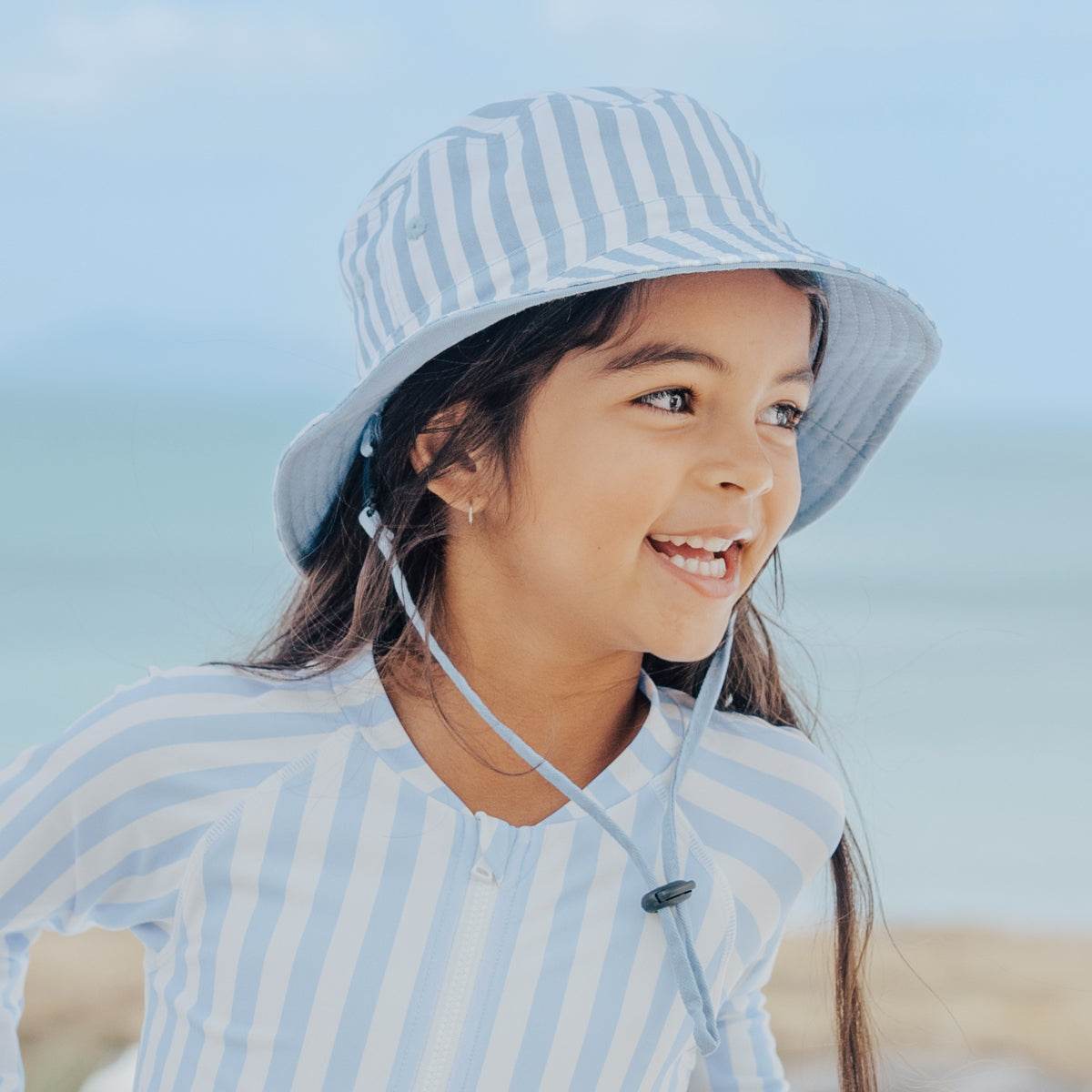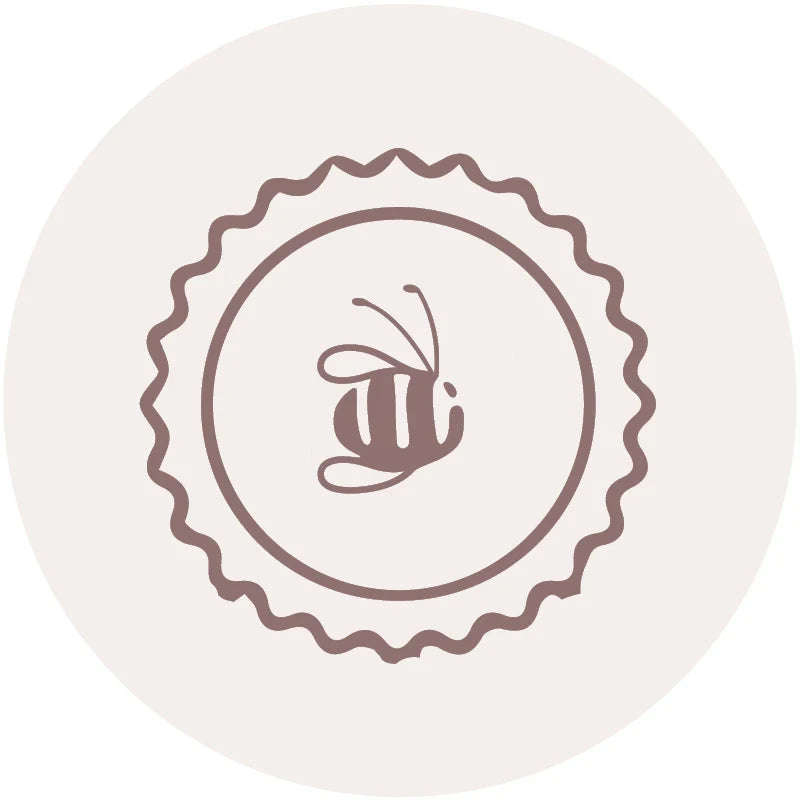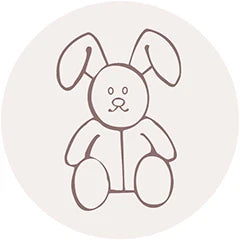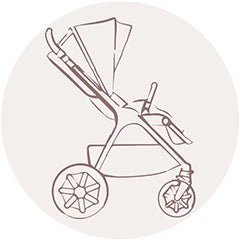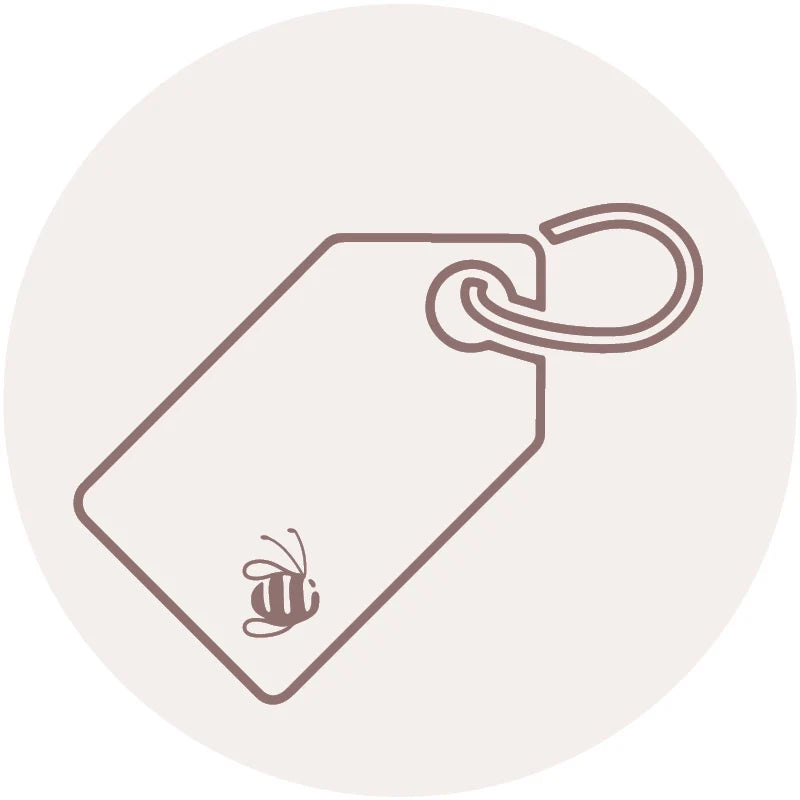Reversible Bucket Hat
Reversible Bucket Hat
SKU:CWRBUSKY-S
Clothing Prem to 18 Months
| Size | Age Guide | Weight | Height |
|---|---|---|---|
| Premature | Premature or Small Newborn | Up to 4Kg | Up to 55cm |
| Newborn | 0-3 months | 4-6Kg | Up to 62cm |
| 3 Month | 3-6 months | 6-8Kg | Up to 68cm |
| 6 Month | 6-12 Month | 8-10Kg | Up to 76cm |
| 12 Month | 12-18 Month | 10-12Kg | Up to 84cm |
| 18 Month | 18-24 Month | 12-14Kg | Up to 92cm |
Clothing 2 to 6 Years
| Size | Age Guide | Height | Chest | Waist | Hip |
|---|---|---|---|---|---|
| 2 Year | 2-3 Years | Up to 100 cm | 56 | 51 | 58 |
| 3 Year | 3-4 Years | Up to 105 cm | 58 | 53 | 60 |
| 4 Year | 4-5 Years | Up to 110 cm | 60 | 55 | 62 |
| 5 Year | 5-6 Years | Up to 115 cm | 62 | 57 | 64 |
| 6 Year | 6-7 Years | Up to 120 cm | 64 | 59 | 66 |
Beanie Size Guide
| Size | Head Circumference | Age Guide |
|---|---|---|
| Premature | 31-35 cm | Premature or Small Newborn |
| Newborn | 35-40 cm | Newborn |
| Small | 40-43 cm | 3-6 Months |
| Medium | 43-47 cm | 6-18 Months |
| Large | 47-52 cm | 18-3 Years |
Sunhat Size Guide
| Size | Head Circumference | Age Guide |
|---|---|---|
| Newborn | 37-40 cm | Newborn |
| Small | 40-43 cm | 3-6 Months |
| Medium | 43-46 cm | 6-12 Months |
| Large | 46-49 cm | 12-24 Months |
| Xtra Large | 49-54 cm | 2-4 Years |
Sleep Pods Size Guide
| Size | Weight | Age Guide | Measurement(Back to Hem) |
|---|---|---|---|
| Newborn | 0-6 kgs | 0-3 Months | 60.5 cm |
| Small | 0-8 kgs | 3-6 Months | 66 cm |
Booties Size Guide
| Size | Age Guide |
|---|---|
| Newborn | 0-3 Months |
| Small | 3-6 Months |
| Medium | 6-12 Months |
| Large | 12-18 Months |
Pretty Brave Baby
| Foot Length (mm) | Insole Length (mm) | EU | UK | Age | INT |
|---|---|---|---|---|---|
| 95-104 | 110 | 16/17 | 2 | 0-6m | S |
| 104-114 | 118 | 18 | 3 | 6-12m | M |
| 114-123 | 127 | 19/20 | 4.5 | 12-18m | L |
| 123-137 | 142 | 21/22 | 5.5 | 16-22m | XL |
Pretty Brave 1st Walker
| Foot Length (mm) | Insole Length (mm) | EU | UK | Age |
|---|---|---|---|---|
| 114-120 | 125-128 | 19 | 3 | 1 yr |
| 120-126 | 132-135 | 20 | 3.5 | 1-2 yrs |
| 126-132 | 138.5-141.5 | 21 | 4.5 | 1-2 yrs |
| 132-138 | 145-148.5 | 22 | 5 | 2 yrs |
Crywolf Swim Nappy
| Size | Length (waist to crotch) | Crotch Width (side to side) |
|---|---|---|
| 0-1 yr | 1-2 yrs | |
| 37 | 38 | |
| 14.5 | 15.5 |
Crywolf Rash Suit
| Size | Length (back neck to crotch) | Chest (arm to arm) | Waist (side to side) | Sleeve (neck to cuff) | Neck Opening(diameter) |
|---|---|---|---|---|---|
| 6-12 Months | 1 yr | 2 yrs | 3 yrs | ||
| 40 | 42 | 44 | 46 | ||
| 25 | 26 | 27 | 28 | ||
| 24 | 25 | 26 | 27 | ||
| 30 | 31.5 | 33 | 34.5 | ||
| 13.25 | 13.25 | 13.8 | 14.3 |
In stock
Couldn't load pickup availability
Overview
Overview
An essential outdoor companion, the Reversible Bucket Hat will keep kids protected from the sun on their everyday adventures.
Crywolf Bucket Hats are cleverly designed, featuring a removable chin strap with an adjustable toggle, that easily threads through the brim to allow the hat to be worn both ways.
Made from natural cotton twill and available in a range of colours and prints.
Key Features
Key Features
Fit & Care
Fit & Care
Delivery and Returns
Delivery and Returns
- Delivery: Free within NZ on orders over $100 (excluding bulky items) or $8 standard shipping
- Returns: Accepted within 14 days of receipt with proof of purchase
- Some items are excluded from returns including sale items, hardware, car seats, prams, monitors and personal items - please click here for the full list.
Share this product
Recently viewed products
Related Blogs
Summer smart, right from the start
Keeping little ones safe this summer After a long, cold, virus-heavy winter, many parents will be looking forward to summer – warmer days, fewer illnesses, and time outside with the kids. But after last year’s record-high temperatures, it’s important to remember that summer has dangers too. Babies, with their delicate skin and inability to regulate temperature, are particularly sensitive to harsh sun and heat. Make sure you’re aware and prepared before summer starts, so you can protect your wee ones – no matter how hot it gets. Here’s our summer safety toolkit: Safer with sunscreen Babies and small children have delicate skin that burns easily, so sunscreen is a non-negotiable in the summer months. Even if your children hate the application process, it’s still something that has to be done. If you make it a regular part of their morning routine, they’ll get used to it eventually. • Choose a broad-spectrum sunscreen with SPF30+ at minimum. • Apply sunscreen at least 15 minutes before you go outside, and remember to reapply every 3-4 hours. • Use plenty – apply sunscreen thickly, and don’t miss areas like the back of the arms or ears. • Keep bottles of sunscreen everywhere – the car, the baby bag, grandparents’ house – so you’re never caught without it. • Don’t forget sunscreen on cloudy days – 80% of rays penetrate through cloud cover, so you can still get burnt. Buy the Made 4 Baby SPF50 Natural Sunscreen HERE . Shade solutions Sunscreen is a must if you’re out in the sunshine, but it’s not the only way to prevent sunburn or overheating. Staying indoors or in the shade during the hottest part of the day helps you avoid the heat altogether while dressing appropriately keeps you – and your children – safe and comfortable. • Try to avoid the sun between 11am-4pm, when UV rays are strongest. • Dress your children in loose, dark-coloured or UV-protective clothing and swimwear – the sun’s rays can penetrate light, thin fabrics. • Choose long-sleeved swimwear. • Make sure your babies and children always wear hats – full brim is best. • Use a sunshade or cover for your pram – but make sure it’s not preventing airflow to your baby, or she could overheat. • Use a shade cloth or stick-on shade in the car, to keep your baby’s seat out of the sun. Check out our range of Cotton Products Here Overheating and hydration During the summer months, it’s important to keep babies and children hydrated and cool as much as possible. Because they’re less developed than adults, babies and small children can’t regulate their body temperature properly, which means they’re more susceptible to overheating. During record high temperatures, overheating and dehydration can be a real concern for smaller babies. Although it’s less common in New Zealand’s fairly temperate climate, babies have died of heat exhaustion in extreme weather • Keep small children indoors, preferably with air conditioning on, during very high temperatures. • Make sure children drink plenty of fluids – homemade ice-blocks are a great way to get more liquid into them. • Give breastfed babies more frequent feeds – your milk will naturally be less concentrated to keep your baby hydrated. Drink more water yourself. • Bottle-fed babies should also be given more feeds – you can offer small amounts of water if you’re concerned about dehydration. • Dress babies and children lightly for sleep, and use a fan or air conditioning to keep the temperature in their room down. • Never leave a baby or child alone in the car, as temperatures can rise extremely rapidly. • If your baby or child is showing signs of dehydration or heatstroke – including lethargy, a dry mouth, fewer wet nappies, or a sunken fontanelle – seek medical treatment immediately. If it all sounds a bit alarming, don’t worry. Summer should be a time of fun and relaxation, even when you do have small children. As long as you’re aware and well prepared, you – and your wee ones – should be fine. Don't Forget the Sunscreen! Buy Sun Lotion Here
Learn moreProtection: Sun Safety for little eyes
Many of us had the sun smart Slip, Slop, Slap message drummed into us from childhood. But are you aware of Slip, Slop, Slap, and Wrap? The message is to slip on some clothing and into the shade, slop on sunscreen, slap on a hat, and wrap on sunglasses. Why are sunglasses important for babies and toddlers? Sunglasses are important to protect your eyes and the delicate skin around them. This is especially important for babies and children for whom overexposure to UV radiation can cause a predisposition to eye problems. Just as a baby’s skin is more vulnerable to the sun, their developing eyes also have an increased susceptibility to UV damage. The New Zealand Association of Optometrists (NZAO) says most of the eye damage caused by UV radiation builds up over a long period of time and cannot be reversed. So the sooner you start protecting your little one’s eyes from the sun, the lower their risk will be of ever developing future eye problems. “There is some evidence that daily exposure to UV radiation in very bright sunlight over many years may increase the risk of developing cataracts which cause a gradual clouding of the natural lens of the eye. Exposure may also increase the risk of macular degeneration, an eye condition resulting from damage to the retina.” In NZ and Australia, we have to be particularly careful as our peak summer UV levels are roughly 40% higher than those at comparable latitudes in the Northern Hemisphere. That’s because Earth’s orbit is elliptical, which means the Southern Hemisphere is closer to the sun during our summer. The thickness of the ozone layer is also a factor as is our clearer air quality. How to choose sunglasses for little ones Treat sunglasses as a necessity, not just an accessory. Although they certainly can be a fun fashion accessory and look super cute on babies! You’ll want to find sunglasses that offer 100% UV protection, like the Izipizi range . Polarized lenses are also a bonus as they protect against glare, giving visual comfort. Opting for grey lenses also means they don’t distort but instead respect natural colours Durability is also key with kids' glasses. Izipizi’s ultra-flexible, BPA-free, and hypoallergenic frames are also great for sensitive skin. In addition, straight arms mean they will also adapt to your baby’s growth. Of course, it's easier said than done to keep sunglasses on a wriggly baby every time you head outside! That’s why Izipizi baby and kids sunglasses come with an optional ultra-flexible and adjustable silicone strap. This helps keep glasses on so they don’t get lost. Finding a comfortable fit will also make your little one happier to wear them. IZIPIZI offers three kids sunglass ranges: Baby for 0-9 months (head size 34-41 cm) Kids for 9-36 months (head circumference 40-47 cm) Kids+ for 3-5 years (head size 46-53 cm) Lead by example, if your children see you wearing sunglasses, they’re more likely to want to wear them too! Getting little ones to wear sunglasses not only protects their eyes now and for the future, it helps them develop habits that last for life. Don’t forget those other sun smart rules: Find shade — especially for babies under 6 months. Car sunshades and stroller sun covers are a good investment. Choose a wide-brimmed hat Try to limit your sun exposure between 10 am and 4 pm when the sun's rays are most intense Dress kids in cool clothing with good coverage Use sunscreen daily, even on a cloudy day.
Learn moreBaby Swimming Lessons
Swimming is a key life skill, especially when you live in NZ - an island nation with a vast coastline, not to mention all the rivers and lakes. Taking your little one to swimming lessons can have many benefits including the physical (coordination, strength, and motor skills). It’s also a bonding opportunity for Mum, Dad or caregiver to have fun interactions with baby and create memories. And of course, there’s the safety benefit. According to Water Safety NZ, one of the leading causes of death for the under-fives in New Zealand is drowning. Introducing your baby to swimming lessons can be a fantastic way to help them develop water safety skills as well as confidence. Start them young Babies spend their first nine months of existence floating in a pool of warm liquid, so reintroducing them to water is something of an instinctive experience. A good first step to developing water confidence in babies is making bath time engaging and enjoyable. If, with lots of positive reinforcement and support, you can get them used to having water trickling over their head and face, that’s a great start. Swimming lessons Once they’re six months old, babies can go to water safety lessons at a public pool By this age Their immune system will have developed enough give them protection from bugs in the pool water They’re better able to cope with the changes in temperature They’ll have the necessary head control to keep their head above water Their ears will be better able to deal with water if it gets in. Baby swimming classes are less about learning to swim and more about water familiarisation and confidence. Over time they’ll start to make progress towards essential water safety skills, including how to float, kick, and hold their breath. Generally with baby swim classes, Mum or Dad (or grandparent or other caregiver) gets in the pool too, joining in to help build bub’s confidence and keeping things fun with interactive play. It’s likely to start with gentle splashing and activities that encourage movement through the water. Tips for swimming lessons Family changing rooms are great and, if there's room, take your stroller. If you get your little one changed, they can then sit in the stroller while you get changed. Swimming will use up lots of energy – make sure you’ve got what you need to re-fuel them afterwards, whether it's a breast or bottle feed, or a snack Changes in temperature can be hard on little ones – make sure you dress them warmly for the trip out to the car in colder weather. If possible, bring along an extra person to help, it can make all the difference especially if you have both a baby and an older child having lessons. What you need Babies will need a swim nappy . These reusable ones offer an adjustable fit from baby to toddler and are machine washable. When choosing swimwear, opt for chlorine-resistant swimsuits for girls and boys that offer 50+ sun protection so they work for the pool or beach A towel Hooded towel or robe can be great for getting them warm and dry quickly A padded change mat is great to have when faced with a damp changing room Dry clothes and spare nappies to keep everyone snug and happy post-swim. Be Safe Always be aware of the dangers for little ones around water – be that the bath, beach or pool. Never leave them unattended. Babies and toddlers should always be within arms’ reach when you’re in or around water - don’t rely on flotation aids like air rings or armbands. Be alert to hazards in your environment. Swimming pools and spas must be fenced to NZ Standards. Consider also ponds, water features and paddling pools that might be a danger to a curious little one.
Learn more







